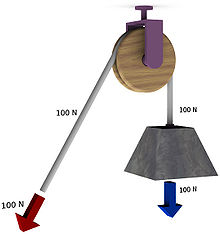Simple machine
mechanical device that changes the direction or magnitude of a force
A simple machine is a device that can change the direction or the magnitude of a force, or the point where it is applied. This is done so that the force can be used to do work. All mechanical machines are made by combining simple machines.

There are six basic "simple machines", as defined by Renaissance scientists:[1]
- The lever (also called a rope or staff) can move the point at which a force is applied and may also change the magnitude and direction of the force.
- The wheel changes the direction in which the force is applied.
- The pulley changes the point where a force is applied and may also change its magnitude and direction.
- The inclined plane allows one to use less force to move an object.
- The wedge is a tool used to push two things apart such as the blade of a sword and knife does when it cuts wood it also can be used to lift an object or hold an object in place.
- The screw that converts rotational motion to linear motion, and a rotational force to a linear force.
The use of simple machines can be traced back to homo habilis (the first humans to use tools), but certain animals other than man also use them.
A compound machine is made up of two or more simple machines.
References
change- ↑ Anderson, William Ballantyne (1914). Physics for technical students: mechanics and heat. New York, USA: McGraw Hill. pp. 112–122. Retrieved 2008-05-11.